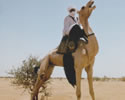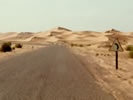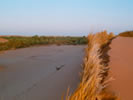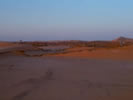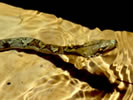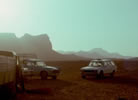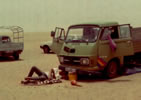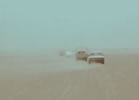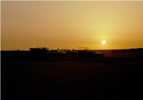On the road in Algeria - crossing the Sahara
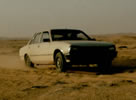
One way to get killed in the Sahara ...
There are two main passages across the Algerian Sahara. The Tanezrouft route via Reggane is 1300 Km of corrugated dirt road into Mali - four days of serious "shake-and-bake." The other route is the Hoggar route, which leads via Tamanrasset across 600 Km of dirt road into Arlit in Niger. It can take 2-3 days for this stretch of 'piste' as well, because the sand is at times pretty bad. And people crazy enough to try to haul a bunch of junkers across the desert are lucky to make it at all.
In July 1990, after we met in Morocco, Andy and I were headed due south, after crossing into Algeria from Morocco at Beni-Ounif. In Reggane we hooked up with a group of French car traffickers who were on their third or fourth tour that summer, moving old, beat-up Peugeots from France into Niger. They had two late '60s Peugeot 404 camionettes bâchée (covered pick-ups) a 405 station wagon from the 70s and two early-80s Peugeot 505. The station wagon was a front-wheel drive and did great, but the pick ups were a real drag in the sand.
Sahara bookmarks:
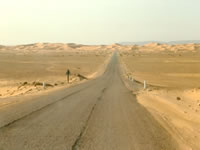 Just
driving in the desert is not easy. There are many hazards, like falling
asleep, because it's so fucking hot and boring. Drivers have been known
to break their necks, racing across a seemingly flat stretch, when they
hit one of the 2-3 foot (1 m) deep dips, that run across the plains in some
places. There have been uncounted head-on collisions of two lonely cars
racing across a hundred-mile wide open plain, because they cannot decide
who is going right, and who is going left. One of the most famous, most
bizarre traffic accidents might have been the truck that ran into the the
famous Arbre
du Téneré - killing perhaps the most remote tree on
the planet in the middle of the Téneré in Niger.
Just
driving in the desert is not easy. There are many hazards, like falling
asleep, because it's so fucking hot and boring. Drivers have been known
to break their necks, racing across a seemingly flat stretch, when they
hit one of the 2-3 foot (1 m) deep dips, that run across the plains in some
places. There have been uncounted head-on collisions of two lonely cars
racing across a hundred-mile wide open plain, because they cannot decide
who is going right, and who is going left. One of the most famous, most
bizarre traffic accidents might have been the truck that ran into the the
famous Arbre
du Téneré - killing perhaps the most remote tree on
the planet in the middle of the Téneré in Niger.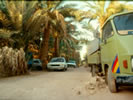
Camp in Tit
Shortly after Reggane, the rear axle of one of the bâchées broke. We were stuck in the tiny oasis Tit for a couple of days, while two of the French guys were getting the axle fixed in Reggane. We camped out in the gardens, where an artesian source supplies a steady stream of cool, clear water. There were only few scorpions and sand fleas, so this could have been relaxing, had it not been for a distinct lack of food. Due to some national holiday, the one store in town was closed, so we could not even get cans of sardines or Maggie cubes. We had nothing to eat, except for some left-over dates.
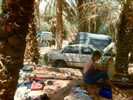
On the second day we were finally able to find someone who was willing to barter a chicken. He insisted that he was not at all interested in money. Cigarettes or whiskey would be great, he said. Andy and I were not inclined to part with our "medicinal" booze quite yet. However, I remembered that I had bought some cheap knock-off "Levi's" in Morocco for a couple of bucks each. The guy with the chicken had really hoped for some genuine Marlboro's, not some fake jeans. But when we offered two pairs, and touted the great Moroccan quality, he agreed. Well, the chicken was really not even worth that. Apparently it was a marathon runner chicken that died of old age, at least judging the quality of the meat. Someone cooked that thing into some kind of stew and we ate it with our dates.
Finally we got back on the road, onwards to In-Salah. The next day was the hottest day of my life. In In-Salah my thermometer recorded 52 degrees Celsius (125 F) in the shade under a tree in town. We even found a restaurant that was open, but did not serve any food, since all the stores were still closed. However, we were lucky - they had a soft-serve ice-cream machine! Now, one of the survival rules in Africa is NEVER to eat soft serve ice cream because these machines are breeding grounds for an assortment the funkiest bacteria. But we watched the guys clean the machine, and this was an extreme case. So we had ice-cream on a day that qualified as a scorcher even in the middle of the Sahara.
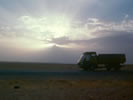
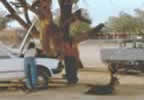 A
day or so later we made it to Tamanrasset, the largest city of southern
Algeria. Tam is quite well developed because it is a tourism center in
the Hoggar mountains. The Hoggar is a stunningly beautiful mountain range
in the central Sahara, and the are features a variety of historic, and
prehistoric sites of interest.
A
day or so later we made it to Tamanrasset, the largest city of southern
Algeria. Tam is quite well developed because it is a tourism center in
the Hoggar mountains. The Hoggar is a stunningly beautiful mountain range
in the central Sahara, and the are features a variety of historic, and
prehistoric sites of interest.
To us, though, the site of interest was one of the larger trees in town. We set up camp underneath, because of trouble with one of the Peugeots. As it turned out sand had gotten inside the clutch, and the only way to get it out was to lift the engine up a couple of inches. So our French friends strung as rope across a branch of the tree and attached it to the engine of the car. Then they attached the other end of the rope to one of the bâchées, using it to gingerly lift the engine of the 505 a few inches, so they could open the clutch and clean it.
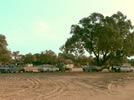
Camp in Tamanrasset
In the meantime, we also provisioned ourselves adequately with dozens of gallons of gasoline, water and several pounds of dates. The next day we'd hit the piste, and it would be three days to the border and another day to Arlit in Niger.
Finally everything was ready. The 505 was put back together and the gasoline, water and dates were stowed away on the trucks. So we hit the only bar in town in the nice hotel near the airport for a couple of beers - lukewarm Heineken at an outrageous price! The only other guests were two Air Algerie pilots - probably (hopefully) off duty. We got talking and the pilots throw one round after another, so it was dark when we got back to our camp. Minutes after we got there, a couple of police cars with lights flashing show up and a stern officer orders us to leave. They want us to stay at a Hotel - no camping inside the city.
We huddled briefly and debated what to do, while one of the French guys kept the cops busy. We had no money for a Hotel, so we discussed trying to bribe them. But the little cash we had left we thought might be more helpful at the border. Also we were not sober enough to get into a real argument with these guys - and they were armed. However, we also knew that camping outside Tam was a bit crazy because of bandits that were roaming the area.
We decided to chance it and leave town. So we packed our shit and left in the middle of the fucking night, with two police cars behind us, escorting us to the city limits. The cops were probably sitting in their cars shaking their heads in disbelieve that we were not at least trying to bribe them. After a while, they turned around, and we stopped at the side of the road. Tired, we just fell asleep in the cars. I think that someone tried to stay awake to keep a guard going, but I just remember waking up the next morning.
 We
took of, hung over and sore, at the crack of dawn. After an hour the asphalt
became really bad. We had to slow down and drive around huge potholes.
Eventually we just drove on the banks, as the asphalt disappeared. Finally
we were on the piste, leaving the Hoggar mountains behind, heading
into the vast desert with not much more to guide us than an occasional
guidepost and the memory of the French trip leader.
We
took of, hung over and sore, at the crack of dawn. After an hour the asphalt
became really bad. We had to slow down and drive around huge potholes.
Eventually we just drove on the banks, as the asphalt disappeared. Finally
we were on the piste, leaving the Hoggar mountains behind, heading
into the vast desert with not much more to guide us than an occasional
guidepost and the memory of the French trip leader.
The piste from Tamanrasset to Arlit is a route that is marked by bidons, little guideposts, theoretically within sight-distance from one-another. However, the marked path is so rutted from the traffic, that many drivers choose the edges of the route, which are smoother, but harder to navigate because you usually cannot see the bidons. In fact, in some areas the piste is several miles wide, which makes it impossible to use the bidons as orientation. But experienced travelers know other landmarks along the edges of the route. One of the French guys had done this trip many times, and most of the others had been through there several times as well. So they knew all the landmarks and sand-traps. Yet, as experienced as they were, they were not infallible. And one stupid mistake in the desert, when you're tired, or off-guard, can be deadly.
And then there are the forks in the piste. At various points, a different piste veers off the main one. There's one that veers off east, toward the Chad. Another veers off west, into Mali. Taking the wrong turn can be deadly, because these routes are much longer, and it may be hours or days before you notice.
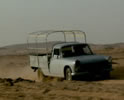
One of the two bâchées
On our first day after Tam, after several hours on the piste, we approached a car with two guys next to it - waving frantically. When we got there, it turns out that they were two Italians on their way to Arlit, and they had run out of water! They asked if we could spare some H2O - sure, where's your container? What happened? As they handed us their plastic gallon jug, they explained that, well, they just kinda ran out of water!
As it turned out, they left Tam with one gallon of water, figuring that, if they ran out, they could always bum some water from someone else! As tempting as it was to just leave these idiots to their fate, we filled the gallon of water, and they had to promise to drive back to Tamanrasset. We waited until they had disappeared in the north, then it was time for us to continue south.
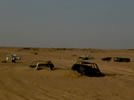
cimetiere des voitures
car graveyard
The second day, we passed an area that's infamously sandy. One spot is called the cimetiere des voitures - the graveyard of cars (see right) - because there are dozens of car wrecks half buried in the sand. We had a really tough time getting our cars through there. We spent a lot of time digging in the hot sand, pushing, shoving planks and sacks under the tires to give them traction.
That evening we broke out our last bottle of Whiskey and finished it. we did not want any trouble at the border the next day.
When we got to the border and the Algerians really fucked with the French. They did not give us Germans too much of a hard time, but they pretty much took all the cash they had and literally had them tear their cars apart. Andy and I were not allowed to wait for them, after we got through the Algerian checkpoint, so we headed on to Assamakka, where the checkpoint for Niger was.
